Polysilicon Market Size and Share
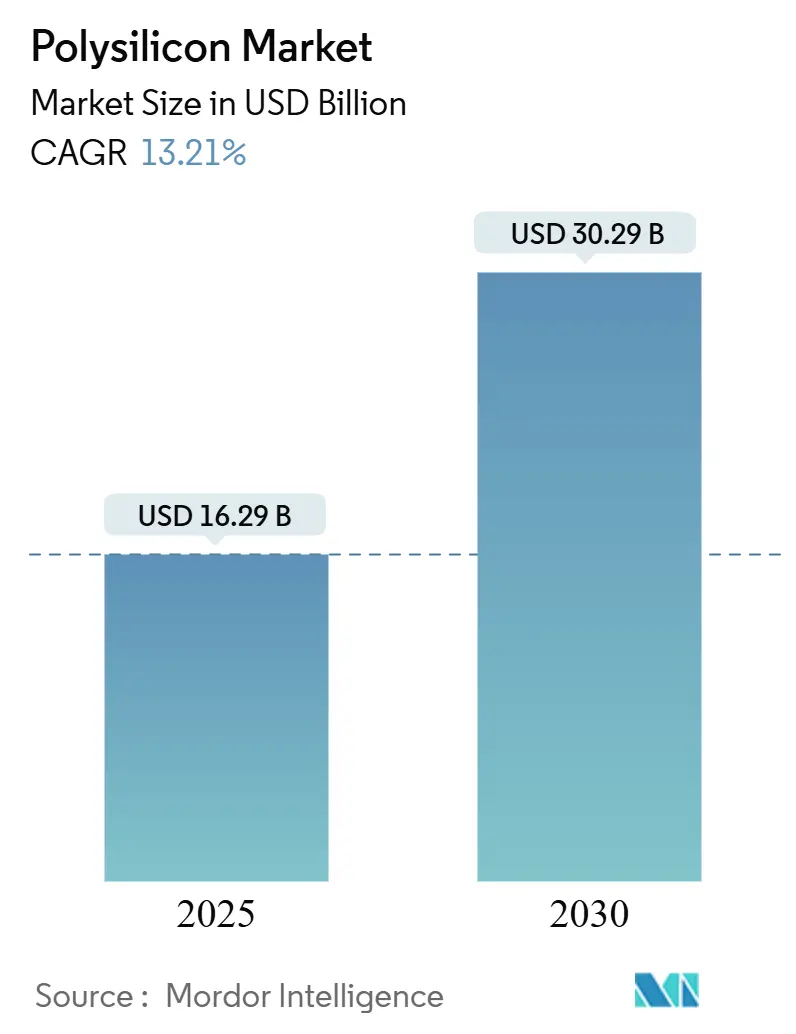
Polysilicon Market Analysis by Mordor Intelligence
The Polysilicon Market size is estimated at USD 16.29 billion in 2025, and is expected to reach USD 30.29 billion by 2030, at a CAGR of 13.21% during the forecast period (2025-2030). This growth trajectory stems from surging solar-PV build-outs, rising semiconductor capital expenditure, and policy incentives that promote regional supply diversification. A sharp pivot toward N-type TOPCon and heterojunction cell architectures is widening the purity gap between commodity and premium grades, while closed-loop silicon recycling advances steadily toward grid-parity economics. Meanwhile, Western forced-labor rules are redrawing trade lanes, creating a dual-pricing environment that rewards traceable, non-Xinjiang feedstock. Cost pressures remain intense as Chinese utilization rates hover below 40%, depressing spot prices even as long-term semiconductor contracts preserve margins for ultra-high-purity producers.
Key Report Takeaways
- By production process, the Siemens TCS-CVD route led with 67.18% polysilicon market share in 2024; the Fluidized Bed Reactor segment is projected to expand at a 14.46% CAGR to 2030.
- By end-user industry, solar photovoltaics accounted for 91.81% of the polysilicon market size in 2024 and is advancing at a 13.73% CAGR through 2030.
- By geography, Asia-Pacific commanded 66.24% revenue share of the polysilicon market in 2024, while also recording the fastest regional CAGR at 13.97% through 2030.
Global Polysilicon Market Trends and Insights
Drivers Impact Analysis
| Driver | (~) % Impact on CAGR Forecast | Geographic Relevance | Impact Timeline |
|---|---|---|---|
| Massive global solar-PV build-out (utility-scale + distributed) | +3.20% | Global, with APAC leading deployment volumes | Medium term (2-4 years) |
| AI-driven semiconductor CAPEX super-cycle (3-nm and below nodes) | +2.80% | North America & APAC core, spill-over to EU | Long term (≥ 4 years) |
| IRA-/Fit-for-55-driven polysilicon onshoring incentives | +2.10% | North America & EU primarily | Medium term (2-4 years) |
| Next-gen N-type TOPCon/IBC cell demand for ultra-high-purity poly | +1.90% | Global, with early adoption in premium segments | Short term (≤ 2 years) |
| Closed-loop silicon recycling economics reach grid parity (2030) | +1.40% | EU and North America leading, APAC following | Long term (≥ 4 years) |
| Source: Mordor Intelligence | |||
Massive Global Solar-PV Build-Out
Global PV installations accelerated from 191 GW in 2022 to 444 GW in 2023, a 132% surge that compressed upstream supply chains and fortified polysilicon market demand. Developers raced to lock in modules ahead of China’s June 2025 grid-tariff shift, stretching feedstock lead times beyond typical 18-month capacity additions. Although fresh Chinese reactors are entering service, commissioning lags keep inventories thin in high-efficiency grades. Project pipelines in India and Southeast Asia compound the pull on available volumes, reinforcing a multi-year growth runway despite current price softness. Forward contract activity indicates that buyers remain willing to pay premiums for traceable, non-Xinjiang material to ensure regulatory compliance in the United States and Europe.
AI-Driven Semiconductor CAPEX Super-Cycle
Advanced logic and memory fabs below the 3-nm node consume up to triple the high-purity polysilicon per wafer versus legacy lines because of tighter contamination thresholds. Annual foundry investments topping USD 200 billion underpin long-dated offtake agreements that shield suppliers from solar price volatility. The U.S. CHIPS Act (USD 52 billion) and the EU Chips Act together aim to boost local wafer output to 20% of global share by 2030, pulling incremental polysilicon tonnage into North America and Europe[1]U.S. Department of Commerce, “CHIPS and Science Act Implementation,” commerce.gov . Producers capable of 11N-grade specifications capture 300-400% price premiums over solar-grade parcels, cushioning margins and funding process upgrades.
IRA and Fit-for-55 Onshoring Incentives
Section 45X of the Inflation Reduction Act grants USD 3 per kilogram for domestic polysilicon, erasing up to half of U.S. production costs[2]U.S. Department of Energy, “Inflation Reduction Act – Advanced Manufacturing Credits,” energy.gov . REC Silicon’s 14-kilotonne Moses Lake restart, scheduled for late 2025, exemplifies how the subsidy revives mothballed assets. In Europe, the Net-Zero Industry Act targets 40% local output of strategic clean-tech materials by 2030, prompting feasibility studies in Germany and Norway. Although financing pipelines is robust, construction lead times mean Western capacity will remain tight until 2027, maintaining price spreads between compliant and non-compliant feedstock.
Closed-Loop Silicon Recycling Reaches Parity
Fraunhofer ISE studies a project that closed-loop recycling could meet 55% of wafer-grade silicon demand by 2030, slicing manufacturing costs by 20% relative to virgin inputs. Mechanical and chemical recovery methods are now achieving 99.9999% purity, approaching the threshold for N-type ingot casting. In Germany and the United States, pilot plants are scaling to multi-kilotonne capacities, aided by EU waste-directive mandates and U.S. Advanced Manufacturing Office grants. As recycled silicon gains bankability, long-term supply contracts emerge, heralding a structural swing in feedstock sourcing by the decade’s end.
Restraints Impact Analysis
| Restraint | (~) % Impact on CAGR Forecast | Geographic Relevance | Impact Timeline |
|---|---|---|---|
| Prolonged 2024-26 capacity overhang & sub-cash-cost pricing | -2.30% | Global, with APAC most affected by oversupply | Short term (≤ 2 years) |
| UMG-Si substitution risk in low-spec PV segments | -1.60% | Global, particularly in cost-sensitive applications | Medium term (2-4 years) |
| Western forced-labour audit rules on Xinjiang feedstock | -2.10% | North America & EU primarily, affecting global supply chains | Medium term (2-4 years) |
| Source: Mordor Intelligence | |||
Prolonged Capacity Overhang
Chinese producers ran at roughly 33% utilization in Q1 2025, selling below cash costs as spot prices plunged from CNY 72,100 to CNY 34,000 per ton. The glut stems from 2021-23 build-outs that outpaced wafer line expansions, locking the polysilicon market into a clearing-price mentality through 2026. Beijing’s energy-efficiency audits may shutter 20-30% of sub-scale reactors, but the timing remains uncertain. Until rationalization materializes, producers with higher electricity or TCS costs face negative margins and constrained capex, limiting near-term technology retrofits.
UMG Silicon Substitution Threat
Plasma refining and directional solidification now enable upgraded metallurgical-grade silicon to reach 20%+ cell efficiencies at 60-70% of polysilicon production cost. Metallurgical smelters can convert furnaces swiftly, posing a disruptive threat to commodity solar-grade demand, especially in emerging regions where module price outweighs efficiency. While UMG feedstock still falls short of N-type purity, its rapid cost decline could erode 15-20% of P-type polysilicon sales by 2030. Producers lacking premium-grade capabilities risk margin compression unless they diversify into recycling or semiconductor channels.
Segment Analysis
By Production Process: Siemens Dominance Faces FBR Efficiency Challenge
Siemens reactors retained a 67.18% polysilicon market share in 2024, producing 11N-grade output prized by both solar and semiconductor buyers. Yet, sustained commodity price erosion heightens focus on power consumption; Siemens lines draw 60-70 kWh per kilogram, pressuring margins in high-tariff regions. The polysilicon market size for Fluidized Bed Reactor (FBR) output is projected to surge at 14.46% CAGR, aided by 25% lower electricity use and continuous powder discharge that trims capex per tonne. Recent Tsinghua University studies confirm 40% higher deposition rates in optimized FBR columns, bolstering adoption for brownfield retrofits. Still, FBR vendors must address powder contamination risks to penetrate the semiconductor space. Upgraded metallurgical-grade silicon occupies a niche today, but pilot plants in Canada and Norway signal growing interest among vertically integrated wafer firms seeking cost ceilings.
Power-price arbitrage is shaping global investment patterns: Middle East projects leverage sub-USD 0.03/kWh renewables to justify Siemens builds targeting 10N-grade solar feedstock, while U.S. Gulf Coast lines employ combined-cycle gas to exploit Section 45X tax rebates. Environmental scrutiny also plays a role; European financiers require lifecycle CO₂ disclosures, favoring FBR’s lower per-kilogram carbon footprint. Overall, technology choice is becoming a strategic lever, balancing capex, opex, purity, and carbon criteria across regional energy landscapes within the polysilicon market.
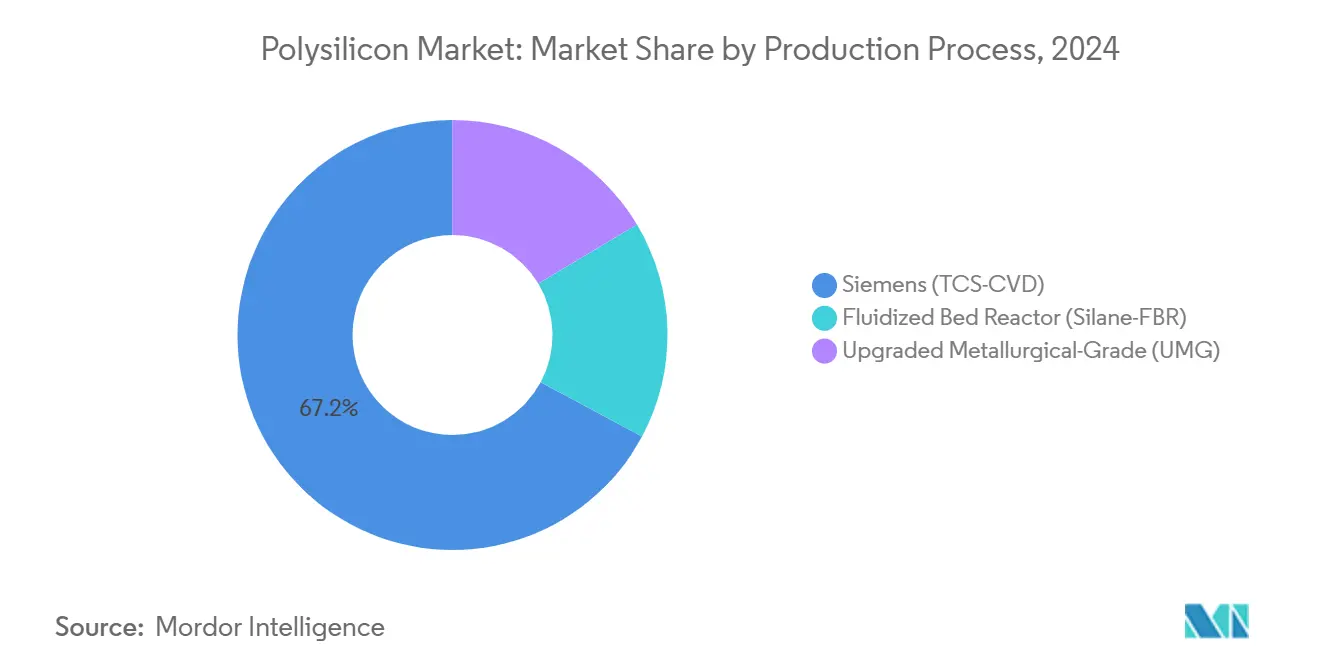
Note: Segment shares of all individual segments available upon report purchase
By End-User Industry: Solar PV Dominance Masks Semiconductor Value Premium
Solar photovoltaics commanded 91.81% of the polysilicon market in 2024 and is slated to expand at a 13.73% CAGR through 2030, propelled by record feed-in tariffs and corporate power-purchase agreements. Monocrystalline ingot pullers now represent 85% of wafer shipments, amplifying demand for 10N-plus feedstock. The polysilicon market size tied to semiconductor applications is modest but highly lucrative; 11N-grade parcels fetch 300-400% premiums and often sell under multi-year, take-or-pay contracts. Advanced logic fabs ramping in Arizona, Dresden, and Kumamoto are already reserving allocations years ahead, shielding producers from solar price cycles.
Technological crossover is limited: chlorosilane raw materials are common, yet downstream purification diverges sharply, necessitating dedicated reactors or post-distillation loops. As AI workloads expand, memory fabs are adopting polysilicon gate stacks with ever-tighter dopant windows, reinforcing high-purity demand. Conversely, UMG-Si threatens low-spec multicrystalline module makers in Africa and Latin America, where budget allocations override efficiency gains. The dual-channel structure thus enables suppliers with flexible product mixes to arbitrage volatility, while single-grade firms remain exposed to commodity swings.
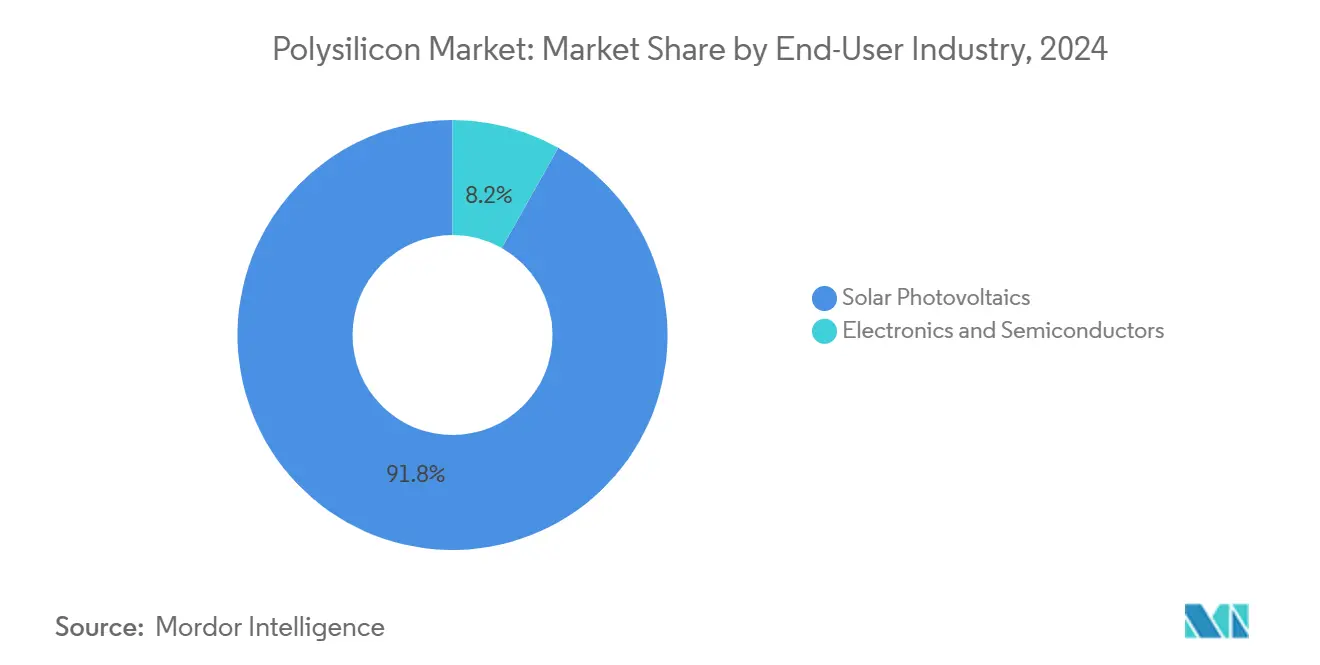
Geography Analysis
Asia-Pacific dominated the polysilicon market with 66.24% revenue share in 2024, riding on China’s integrated supply chain that spans quartz mining to module assembly. Provincial incentives helped Chinese nameplate capacity exceed 400 kilotonnes, yet chronic oversupply slashed plant utilization and triggered margin erosion. India adds a strategic demand layer: its 500 GW renewables target by 2030 implies annual silicon imports exceeding 150 kilotonnes unless local ventures materialize. Japan and South Korea focus on semiconductor-grade volumes, leveraging long-standing purity expertise but facing high electricity costs that hinder brownfield expansions.
North America enters a renaissance phase as the Inflation Reduction Act re-anchors manufacturing. REC Silicon’s Moses Lake restart will deliver 14 kilotonnes of FBR powder by 2026, but U.S. solar installations could exceed 50 GW annually, leaving a structural deficit covered by imports from Malaysia and Germany. Section 301 tariffs and Uyghur Forced Labor Prevention Act detentions complicate logistics, fostering a premium spot market for traceable cargoes. Canada offers hydropower-driven low-carbon electricity, drawing feasibility studies for semiconductor-grade plants aiming at 10-kilotonne scales.
Europe balances ambitious Fit-for-55 targets against steep industrial power tariffs that average EUR 0.27/kWh, twice U.S. levels. Nevertheless, Norway’s hydro surplus underpins proposals for FBR facilities targeting net-zero Scope 2 emissions, a credential valued by EU module buyers. Middle East actors pursue energy-cost arbitrage: Oman’s 100-kilotonne project leverages sub-USD 0.03/kWh solar power and port proximity to serve Asia and Africa. Africa remains an emerging market, with Egypt and Morocco investigating smelter-enabled UMG pathways linked to domestic solar goals.
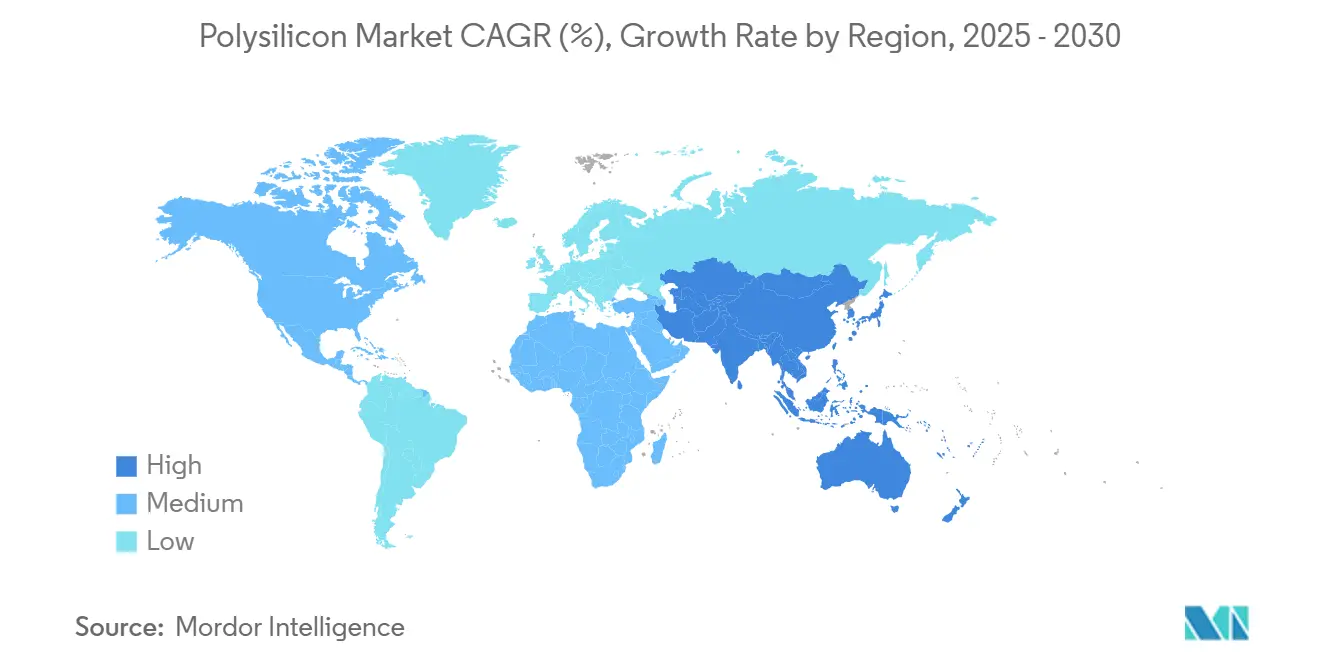
Competitive Landscape
The polysilicon market shows consolidated concentration; the top five suppliers controlled roughly 59% of global capacity in 2024, but spot-price leadership is weak because downstream buyers wield diversified sourcing and inventory strategies. Tongwei and GCL-Tech exploit coal-based captive power in Inner Mongolia to post sub-USD 6/kg cash costs, cushioning them during price troughs. Wacker Chemie differentiates through 11N-grade output serving both solar and semiconductor channels, anchoring long-term contracts with European wafer partners. Daqo New Energy doubled down on TOPCon-grade purity, investing in off-gas recycling loops that lift yield while cutting emissions.
Policy tailwinds are spawning Western challengers. REC Silicon leverages low-cost hydropower and IRA credits to reboot its U.S. line, courting module OEMs seeking non-Chinese origin. Asia-Pacific incumbents respond by fast-tracking FBR retrofits and in-house wafer lines to lock in demand. Silicon recycling start-ups, backed by EU Circular Economy funds, aim to undercut virgin polysilicon on carbon footprint and price by the late 2020s. Meanwhile, metallurgical-silicon producers such as Ferroglobe explore plasma-refined UMG feedstock that could eat into commodity-grade demand, pressuring traditional players to escalate purity or integrate downstream.
Technology licensing is another battleground. Western export-control regimes restrict ultra-high-purity process kits, compelling Chinese firms to develop domestic reactors and distillation systems. This localization push narrows the historical IP gap but raises capex. Joint ventures between Middle Eastern energy majors and Japanese engineering houses underscore a shift toward geographically diversified, low-carbon supply. Overall, competitive dynamics hinge on cost discipline, purity innovation, and regulatory compliance within the polysilicon market.
Polysilicon Industry Leaders
-
Tongwei Co., Ltd
-
GCL-TECH
-
DAQO NEW ENERGY CO. LTD
-
Wacker Chemie AG
-
Xinte Energy Co. Ltd
- *Disclaimer: Major Players sorted in no particular order
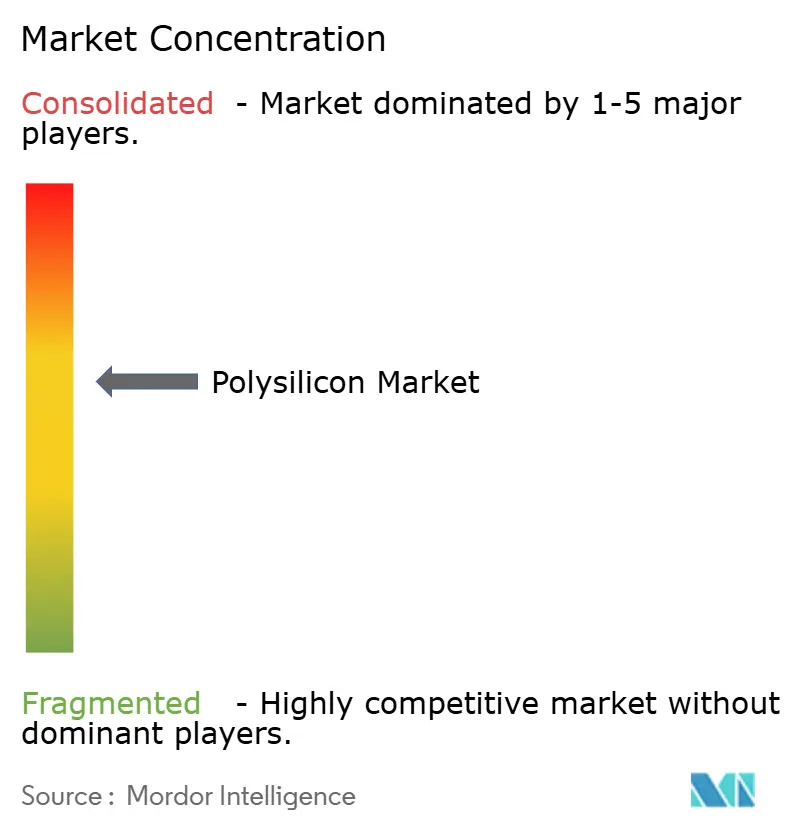
Recent Industry Developments
- July 2025: OCI Company and Tokuyama Corporation have initiated the construction of a USD 435 million polysilicon manufacturing facility on Borneo Island, Malaysia. The plant is designed to produce 10,000 tonnes of polysilicon annually, with operations expected to commence in 2027.
- August 2025: The World Bank has approved a significant loan and investment package of up to USD 250 million to support United Solar's polysilicon production plant. Construction of the facility began in March 2024 in the Sohar Free Zone, Oman, and it is designed to achieve an annual production capacity of 100,000 tons.
Global Polysilicon Market Report Scope
Polycrystalline silicon is the key feedstock in the crystalline silicon-based photovoltaic industry and is used for the production of conventional solar cells. The polysilicon market is segmented by the end-user industry and geography. By end-user industry, the market is segmented into solar PV (monocrystalline solar panel, multi-crystalline solar panel) and electronics (semiconductor). The report also covers the market size and forecasts for the market in 15 countries across major regions. The report offers the market size and forecasts in revenue in USD million for all the above segments.
| Siemens (TCS-CVD) |
| Fluidized Bed Reactor (Silane-FBR) |
| Upgraded Metallurgical-Grade (UMG) |
| Solar Photovoltaics | Monocrystalline Solar Panel |
| Multicrystalline Solar Panel | |
| Electronics and Semiconductors |
| Asia-Pacific | China |
| India | |
| Japan | |
| South Korea | |
| Rest of Asia-Pacific | |
| North America | United States |
| Canada | |
| Mexico | |
| Europe | Germany |
| United Kingdom | |
| France | |
| Italy | |
| Rest of Europe | |
| South America | Brazil |
| Argentina | |
| Rest of South America | |
| Middle East and Africa | Saudi Arabia |
| South Africa | |
| Rest of Middle East and Africa |
| By Production Process | Siemens (TCS-CVD) | |
| Fluidized Bed Reactor (Silane-FBR) | ||
| Upgraded Metallurgical-Grade (UMG) | ||
| By End-user Industry | Solar Photovoltaics | Monocrystalline Solar Panel |
| Multicrystalline Solar Panel | ||
| Electronics and Semiconductors | ||
| By Geography | Asia-Pacific | China |
| India | ||
| Japan | ||
| South Korea | ||
| Rest of Asia-Pacific | ||
| North America | United States | |
| Canada | ||
| Mexico | ||
| Europe | Germany | |
| United Kingdom | ||
| France | ||
| Italy | ||
| Rest of Europe | ||
| South America | Brazil | |
| Argentina | ||
| Rest of South America | ||
| Middle East and Africa | Saudi Arabia | |
| South Africa | ||
| Rest of Middle East and Africa | ||
Key Questions Answered in the Report
How large is the polysilicon market today and how fast is it growing?
The polysilicon market size stands at USD 16.29 billion in 2025 and is projected to reach USD 30.29 billion by 2030, registering a 13.21% CAGR.
Which region leads global polysilicon demand?
Asia-Pacific accounts for 66.24% of 2024 revenue, underpinned by China’s vast solar module ecosystem and rapid installations in India, Japan, and Southeast Asia.
What production technology is gaining ground on the legacy Siemens process?
Fluidized Bed Reactor lines are scaling quickly because they lower electricity use by about 25% and are forecast to grow at a 14.46% CAGR through 2030.
Why is semiconductor-grade polysilicon strategically important?
High-purity 11N-grade feedstock earns 300-400% price premiums and secures multi-year contracts with advanced fabs, stabilizing revenue when solar prices slump.
How do U.S. and EU policies impact polysilicon supply chains?
Incentives such as the IRA’s USD 3/kg credit and the EU’s Net-Zero Industry Act encourage local manufacturing, but capacity additions will not fully arrive until 2027.
Page last updated on:



